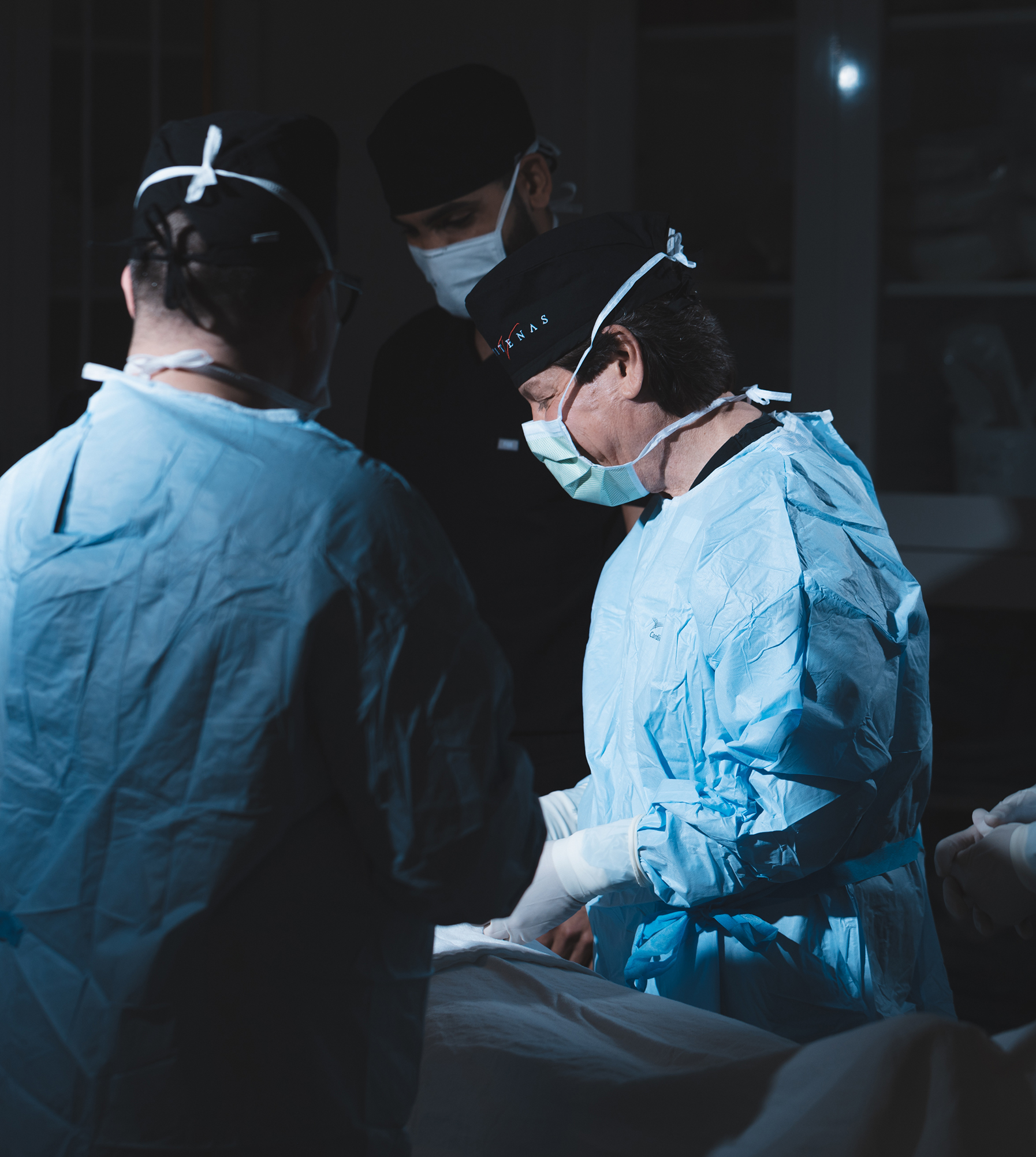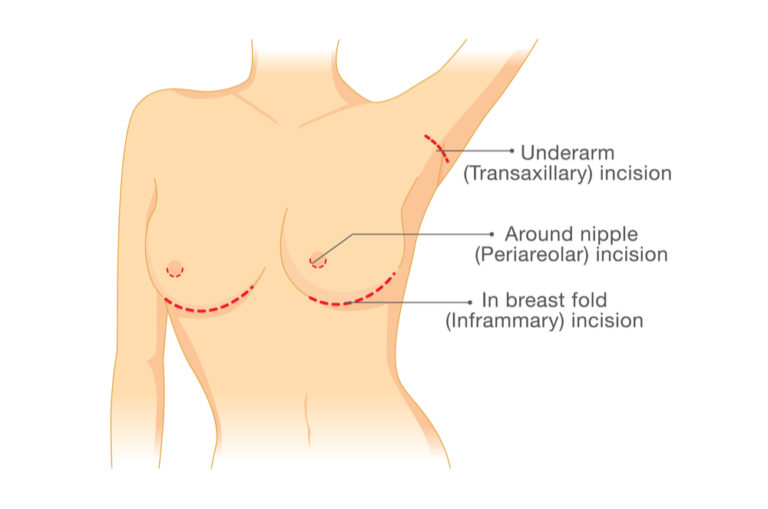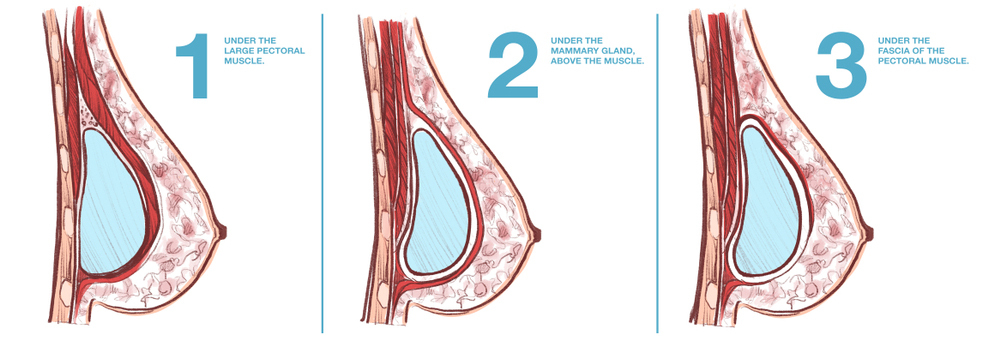Implant Techniques
There are a lot of variables when it comes to breast augmentation. The size of the implants will vary from woman to woman. Implant shape also varies. And let’s not forget that you also have two major options when it comes to implant material, either silicone or saline.
Reserve a Free VIP Consultation

One factor that also influences the results of breast augmentation, but that few people really think about, is breast implant placement. Typically, the implants can be placed either over the chest muscle (sub-glandular) or under the chest muscle (sub-muscular). There’s no one “right” breast implant placement, although some surgeons often prefer one method over the other.

Understanding Breast Anatomy


Breast Implant Options
Silicone implants are also FDA-approved for cosmetic breast augmentation and breast reconstruction. The FDA has given them the go-ahead for women over age 22 when used for cosmetic reasons and for women of all ages when used for reconstruction.
The implants contain a thick silicone gel. Unlike saline implants, silicone implants are pre-filled. There’s no way to adjust their size after placement.
Whether you choose silicone or saline implants affects the technique a surgeon will use and also affects the positioning of the implant. But there are a few other things to consider when choosing the type of implant.
The shape of the implant affects the final results of your surgery. Saline implants are typically round and provide fullness to the breast. Silicone implants can also be round or they can be teardrop-shaped.
Schedule A Consultation
Breast Implant Positioning

How Under-the-Muscle Placement Works
The chest muscle is known as the pectoralis major. When an implant is placed under the chest muscle, the muscle tissue covers it.
During the surgery, the surgeon makes a pocket in the breasts between the chest wall and the muscle.
Under-the-muscle positioning is usually a more complicated procedure and often has a longer recovery time compared to over-the-muscle positioning. But it also typically provides superior results, making it the preferred option.
Benefits of Under the Muscle Breast Implant Placement
Under-the-muscle breast implant placement is often recommended for women who don’t have a lot of natural breast tissue. Placing the implant beneath the muscle helps create a more natural shape in women who might be an A-cup or smaller. The muscle helps mask the appearance of the implant, creating a more natural look. Without the extra padding provided by the muscle, some women would end up with very round, fake-looking breasts, which isn’t what many women want.
Along with providing a more natural shape, under-the-muscle placement can help conceal any issues with the implant. Saline implants, for example, have a tendency to ripple. If the implants are placed on top of the muscle and a woman doesn’t have a lot of breast tissue, it’s possible for rippling to be visible beneath the skin.
Placing the implant beneath the muscle is also believed to lower the risk for capsular contracture, a deformity that occurs when too much scar tissue develops around the implant. Sub-muscular placement might also make mammograms easier to read.
Understanding Capsular Contracture
Grade 2 capsular contracture can result in breasts that feel somewhat firm. In grade 2, there usually isn’t discomfort or pain.
Grade 3 capsular contracture can produce unusual-looking breasts. The nipples might appear deformed, the breasts might feel firm and they might look very round. By grade 4, the breasts are usually very visually deformed. They also tend to be sore and tender to the touch.
Although it can be uncomfortable and unsightly, capsular contracture doesn’t typically cause long-lasting health problems. Removing the implants or replacing them typically corrects the issue. Under-the-muscle placement also greatly reduces the chance of it occurring.
Disadvantages of Under-the-Muscle Placement
While under-the-muscle placement is the preferred option by the majority of surgeons and patients, it does have some drawbacks. One potential issue is that the pressure from the chest muscle can cause the implant to shift over time. Smooth, round implants are more likely to shift when placed under the muscle.
The weight of the muscle can also flatten the implant. Women who lift weights or who otherwise have very well-developed chest muscles are more likely to notice some unwanted changes in their implants’ appearance due to the weight of the muscle.
Finally, the recovery after surgery tends to be longer when the implants are positioned under the muscle. A patient might feel more pain after their surgery, as well. Usually, any temporary surgical discomfort can be managed with medication, however.
How Over-the-Muscle Placement Works
Over-the-muscle placement puts the implant on top of the pectoralis major, beneath the glandular tissue of the breasts. It’s sometimes called sub-glandular placement. Sub-glandular placement is often a shorter, simpler procedure to perform compared to placing the implants beneath the muscle. It’s not ideal for women who don’t have much natural breast tissue, as the implant’s edges and contour can often become visible beneath the skin.
The ideal candidate for an over-the-muscle placement is a woman who has a lot of natural breast tissue or a woman with a developed chest muscle. For example, female bodybuilders usually benefit from over-the-muscle placement rather than under-the-muscle.

Benefits of Over-the-Muscle Breast Implant Placement
One of the biggest benefits of the over-the-muscle or sub-glandular implant placement is that the surgery is usually a bit less invasive than the procedure required for under-the-muscle placement. Since the surgeon doesn’t have to cut down to or into the chest muscle, the surgery can take less time. Recovery afterward might also be a bit shorter than the recovery after a sub-muscular placement.
Some women might prefer the results they get from over-the-muscle implant placement. If you have a fair amount of natural breast tissue, you might not need the added camouflage of sub-muscular placement and you might be able to enjoy a natural look.
Often, over-the-muscle placement allows a surgeon to use larger implants than under the muscle placement. While the size of the implants that will be used depends in large part on a woman’s proportions and goals, women who want larger implants might be able to get them with sub-glandular placement but not with sub-muscular placement.
One last benefit of over-the-muscle placement is that the movement of the muscle doesn’t have much effect on the implant itself. When implants are put beneath the muscle, any flexing of the pectorals can alter the shape or the position of the implant. While the effect is temporary and goes away once the muscle is relaxed, it can be something that you want to avoid.
Disadvantages of Over-the-Muscle Breast Implants
Over-the-muscle breast implant placement has some notable drawbacks. If a woman doesn’t have a lot of natural breast tissue (and many women seeking breast augmentation don’t) the implants can be easily seen beneath the skin. Over-the-muscle placement also tends to have a slightly higher rate of capsular contracture.
Finally, over-the-muscle placement can also make routine mammograms more challenging. When the implant is on top of the muscle, it can make it difficult for breast tissue to be seen in medical images. Women who have breast implants, particularly sub-glandular implants, should let the imaging technologist know when they schedule a mammogram. The technologist might need to take x-rays from a different angle or use a different type of technique to make sure they get clear images.
IMPLANT SHAPE AND MATERIAL CAN INFLUENCE PLACEMENT
Along with the natural size of your breasts, the implant material and the size of the implant you choose can influence the ideal placement. Traditional round implants can create an unnatural look if placed on top of the muscle in patients with thin tissues.
Saline implants are often better suited for under-the-muscle placement, thanks to their tendency to ripple. Silicone implants can go in either placement position, although their softer and smoother feel often makes them a better option for sub-glandular placement.
How to Choose the Best Implant Placement
Generally speaking, the less natural breast tissue you have, the more likely it will be that under-the-muscle implant placement will be the best option for you. For the most part, surgeons only recommend an over-the-muscle placement to women who have a considerable amount of existing breast tissue.
Common Myths About Breast Implant Placement
Several myths persist when it comes to the best placement for breast implants. It’s pretty common to be confused when you’re researching breast augmentation, so it’s important to get your information from reputable sources. Here’s what’s fiction and what’s fact. One persistent myth claims that the placement of your implants will determine whether or not your breasts start to sag as you get older. The reality is that breasts might begin to sag as a result of aging and gravity, not because the weight of an implant is pulling them down. Whether the implants are on top or under the muscle won’t affect the shape and lift of the breasts.
If you are concerned about sagging now or in the future, one option is to schedule a breast lift to elevate the breasts and improve their shape. You can have the surgery performed on its own or at the same time as breast augmentation. Another common myth about implant placement claims that putting the implants beneath the muscle gives them some added protection. In reality, an implant put on top of the muscle is no more likely to rupture than one beneath the muscle.
Implants rupture for a few reasons, including wear and tear on their materials or a forceful blow to the chest. If a blow is strong enough to rupture an implant, a bit of extra cushioning on the top usually won’t have much effect or be particularly protective.
Types of Breast Augmentation Techniques
Implant placement is just one decision a surgeon makes when planning each breast augmentation surgery. They also need to decide on the best type of breast augmentation technique to use, based on several factors. There are four main types of breast augmentation techniques. Some techniques can only be used with certain types of implant and some are much more common than others. The type of technique a surgeon uses influences the location and size of the scars after the surgery.
PERIAREOLAR
The periareolar technique is one of the two most popular surgical techniques used during breast augmentation. For this approach, the surgeon makes an incision just underneath the areola. The darker color of the areola usually hides the scar from the incision quite effectively after the procedure. The periareolar technique is ideal for women with smaller breasts, as they might not have a large fold or crease beneath the breasts for the surgeon to use in hiding the incisions. One potential drawback of this type of incision, however, is that it’s very close to the milk ducts. A woman who is interested in breastfeeding after breast augmentation might have some issues with doing so using the periareolar technique, especially if the ducts are cut during the surgery. Options include waiting until after having kids and weaning them to schedule breast augmentation or seeing if other surgical techniques are viable.
TRANS-AXILLARY
The axilla is the armpit, so a trans-axillary technique involves making an incision in the underarm area, then sliding the implant into a pocket formed either under the muscle or over top of the muscle. The transaxillary approach is one of the less common techniques, for a few reasons. The surgeon begins working at a considerable distance from the breasts. It can be more challenging to create a symmetrical result when the implants are positioned from the armpits, rather than placed directly in the breasts. It’s also worth pointing out that there may be a slightly higher risk of capsular contracture or other complications when a surgeon uses the transaxillary approach. One thing that makes the armpit incisions appealing, though, is that they don’t leave scars on the breasts themselves. Since the incisions are in the underarms, they can be easy to conceal with long-sleeved shirts or by keeping the arms down.
INFRAMAMMARY FOLD
The vast majority, up to 80%, according to the University of Michigan, of breast augmentations are performed using a technique that makes an incision in the creases just beneath the breasts. One feature that makes the inframammary fold technique so popular is that it allows a surgeon pretty direct access to the breasts, making it easier for them to position the implants. The location of the incision also means that the milk ducts will be relatively untouched during the surgery, meaning there is little to no effect on a woman’s nipples or breastfeeding ability after surgery. Depending on the amount of breast tissue a patient has, the incision and scar can be easily concealed by the natural sag or crease of the breasts after the implants are placed. Women who have more natural breast tissue or who are older are more likely to have less visible scarring from the inframammary technique.
TRANS-UMBILICAL BREAST AUGMENTATION
The trans-umbilical breast augmentation (TUBA) technique is one of the newer techniques available. It’s also one of the least commonly used, though, for a few reasons. The surgery requires an incision to be made in the abdomen, in the naval. The surgeon then threads a small camera into the incision, up to the breasts. The implants are threaded from the naval to the breasts as well and positioned there using the camera as a guide. Since the surgeon has to work from a distance when using the TUBA technique, there is a notable chance of asymmetrical placement. TUBA, like the transaxillary approach, is only performed with saline implants. The implants need to be positioned before they are filled, to allow the surgeon to thread them from the naval to the breasts.
Your Guide to Choosing a Technique
In all honesty, you might not have much say when it comes to the type of breast augmentation technique your surgeon uses. Many have their preferences, such as the inframammary or periareolar. But if the surgeon does bring the topic up for discussion, here are some things to consider. The amount of natural breast tissue you have will play a big role in determining the type of incision that is right for you. Inframammary incisions are the gold standard but might leave visible scars on women who have little natural breast tissue. Also, having little breast tissue can mean that there isn’t a natural fold or crease beneath the breast.
Also, consider the risk of complications based on the techniques. The further away the surgeon is from the breasts while working, the greater the risk for issues such as asymmetry or complications such as capsular contracture. When talking to your surgeon about techniques, find out which one they prefer, why they use it, and what their success rate is. If you’re interested in a technique that the surgeon doesn’t commonly use, find out if it’s an option or if it’s a method they have used in the past. You want to work with someone who has experience and knowledge of different surgical techniques.

Fat Transfer Breast Augmentation
Although breast implants are the most common way to increase the volume and size of the breasts, they aren’t the only surgical option for breast enhancement. In some cases, your own fat can be used to add volume to your breasts.
Fat transfer is a technique that involves taking fat from places you don’t want it (stomach and thighs are popular sources) and putting it where you want a bit more of a curve (like your bust). So, if you’re contemplating both sculpting your ideal figure with some liposuction and breast enhancement surgery, this might be the perfect answer.
What Is Fat Transfer?
Where Is Fat Transfer Used?
- Hands
- Face
- Calves
- Buttocks
What Can You Expect During Breast Augmentation Fat Transfer?
As mentioned above, fat transfer breast augmentation is a two-part process. First, the surgeon removes fat from one area of the body. How much fat they will remove depends on your goals.
After the surgeon cleans the fat, they inject it into the breasts. In some cases, fat transfer is used along with implants to enhance the breasts and create a natural appearance. It can also be used on its own.
Benefits of Breast Augmentation With Fat Transfer
Using your own fat has many advantages over implants. For a start, it’s natural and requires only a tiny incision to insert the cleaned fat into the breast, along with a similarly small incision to suck the fat out from the buttocks, thighs, or abdomen. The tissue that’s injected back into the body will also continue to live — after all, it’s living cell tissue from your own body — which makes the enhancement permanent. The effect is immediate, long-lasting, and will leave you with a natural curve that can be accurately shaped in a way that is hard, if not impossible, to achieve with synthetic breast implants.
Drawbacks of Fat Transfer Breast Augmentation
Although fat transfer has many benefits for the right candidate, it does have some potential disadvantages, too. One potential drawback of enhancing the breasts with fat transfer is that it can be difficult to predict the final results. When you use implants, you have a general idea of how the breasts will look after the implants are positioned. With fat transfer, there is a chance that the body will reabsorb a considerable amount of the fat, meaning that your breasts might not be as full as you’d like. To account for that, your surgeon might use more fat than they think they need.
Using more fat can mean that you end up with breasts that are fuller or bigger than you wanted. They might reduce in size over time as the body absorbs some of the fat, but there is a chance that they won’t.
Depending on your goals, you might need to schedule multiple sessions of fat harvesting and transfer before you get the results you want. That adds up and requires more recovery. Plus, you must have enough fat for each procedure.
ARE YOU A CANDIDATE FOR BREAST AUGMENTATION WITH FAT TRANSFER?
Not everyone is a candidate for fat transfer breast augmentation. It might be the case that implants will be a better option to help you reach your goals. One thing to consider is how much natural fat you have. If you’re naturally very thin, you might not have enough “extra” fat to use to enhance the breasts. Another consideration is your goals. If you want to add a lot of volume to the breasts, implants might be the better choice. Another option is to use implants and fat together to enhance the breasts.
Both breast augmentation with implants and with fat transfer are surgical procedures that require some downtime. Talk to your surgeon to see how much time you should take off from work or other activities after fat transfer to make sure it will work with your schedule.
Breast Lift Without Breast Implants
A breast lift isn’t the same as breast augmentation but it can be the right option for some people. While breast augmentation adds volume to the breasts, a breast lift improves their shape and position on the chest wall.
The procedure can be performed to reduce sagging breasts or to make the breasts firmer. In some cases, it’s combined with breast augmentation to improve the overall size and shape of the breasts.
If you’re happy with the size of your breasts but not the shape of them, a breast lift alone might be right for you. Look for breast lift before and after photos without implants to get an idea of the typical results.
Implant TechniquesFAQ
You have many options when it comes to the type of breast augmentation and surgical techniques, from the implant used to the incision made. Your surgeon can help you choose the implant and technique that will work best for you.
Scars are inevitable after breast augmentation, but how visible they will be will depend on a number of factors. Periareolar and inframammary incisions typically produce scars that are easy to hide. The scars from a trans-axillary incision can be covered up by clothing or by avoiding raising the arms.
Usually, the position of the implant is permanent, whether it’s under the muscle or over it. Should you need a breast implant revision or exchange later, your surgeon might change the position of the implant then, depending on the reason for the revision and your overall satisfaction with the implants.
Fat transfer breast augmentation might be a good option for some patients but not others. If you’re looking for just subtle enhancement of the breasts, you might prefer to use your own fat rather than an implant. There’s no need to exchange or remove fat, but you might need to replace implants at a later date.
Yes, the fat you use during fat transfer needs to come from your own body. If you use donor fat, there is the risk that the body will reject it. People who are very thin might not be able to have fat transfer if they don’t have an adequate amount of fat.
Your surgeon will help you choose the right incision technique or will make a recommendation based on their preferences. Many prefer the inframammary technique or the periareolar technique over other options.
Capsular contracture is, fortunately, relatively rare, affecting only about one out of six women. There are many ways to reduce your chance of getting it, including choosing an experienced surgeon, having the implants placed under the muscle, and working with someone who minimizes contact with the implants before placement.
After surgery, breast implant exercises can further reduce the risk of developing capsular contracture.
If you aren’t happy with your breast augmentation results, you have options. You can wait a bit to see if the breasts settle into place. You can also replace the implants with a smaller or larger pair. If you have saline implants, you can try silicone, or the reverse. A breast implant revision can also correct asymmetry or complications such as capsular contracture.
Choosing an experienced plastic surgeon is crucial for the success of your breast augmentation. Dr. Paul Vitenas is a board-certified plastic surgeon in Houston, Texas with more than 30 years of experience performing breast surgeries.
He can review the options for surgery with you and explain the methods and techniques he uses, and why. If you have any questions about breast augmentation or would like to learn more about the various techniques, call 281-545-3181 to schedule a consultation with Dr. Vitenas today.

